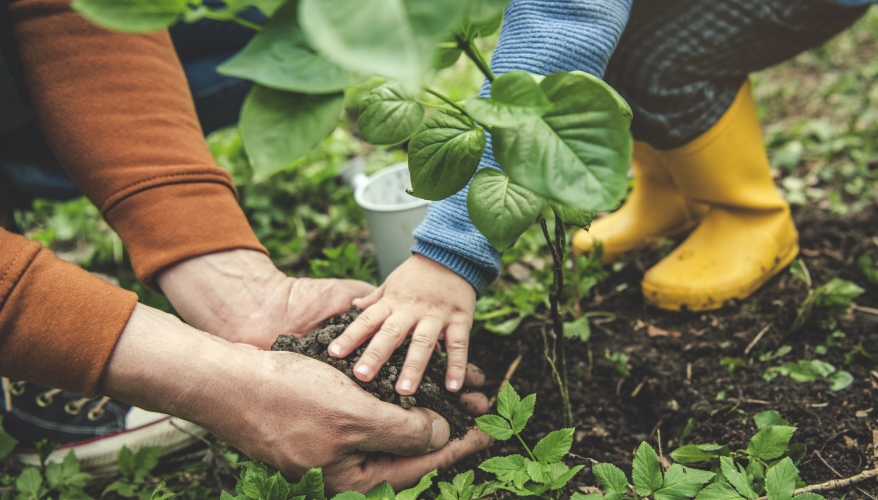What is a forest garden?
A forest garden takes as its model the most wonderfully healthy and productive organic system in Britain—the deciduous woodland. It consists of trees and shrubs, with bushes below and a ground layer of perennial or self-seeding plants underneath. However, unlike a deciduous woodland, all plants in the forest garden are edible or useful in some other way.
The first British forest garden was created by Robert Hart (1913 - 2000) at Wenlock Edge, Shropshire. Inspired by a need for more trees, as well as a need to produce healthy food, he envisaged a time in the future when thousands of forest gardens in towns and cities would together make up great urban forests. His own garden is a beautiful example of what can be achieved. On about an eighth of an acre, many different food-producing trees rise above masses of fruit bushes and herbs—over 70 species in all. These provided much of Robert’s food for over seven months of the year.
Advantages of forest gardening
A forest garden offers a number of advantages over conventional gardening:
- It cuts down on labour, as the ground cover of plants means the garden does not demand constant digging, sowing, planting, hoeing, weeding, or watering. This makes it ideal for people who aren’t up to a lot of physical work, or for people who don’t have a lot of time to spend in the garden.
- It can be more productive than a single crop, because all the vertical space is used as short and tall plants, shallow-rooted and deep-rooted plants grow side by side.
- It is suitable for difficult sites, such as steep slopes and areas with little soil, as the root systems of many perennial plants can penetrate rocky ground.
- It is more resistant to drought than a conventional garden, because mulches and groundcovers stop moisture from evaporating. Once it’s established, a forest garden should never need watering.
- It is more resistant to pests, because the high diversity of plants prevents the plagues that tend to build up on monocultures. Also, mature perennials can cope with attacks from slugs and other beasties that would wipe out rows of vegetable seedlings.
- Its no dig approach preserves the natural structure of the soil, so it stays fertile.
- It provides food and shelter for native animals (and humans enjoy it as well!).
Designing the garden
Remember that every forest garden is different. It can be any size, from a small backyard with one dwarf tree on upwards. Yours should be designed to suit the people who are going to use it: you, your family, school or community.
You’ll need to consider how much time, energy, and resources you want to put into it, and what you want to get out of it. You may decide to include some open sunny patches for sitting, perhaps with a ground cover of low-growing herbs, a pond to attract more wildlife, or an abundance of colourful flowers to cut for the house.
Once you’ve established the purposes of your forest garden, consider the space you’re going to use. Identify the plants already growing there, and decide whether they could become part of the forest garden. Find out if they are edible or have a high wildlife value. Observe the land over an entire year.
Make sure you know the soil type and pH, drainage, local climate, micro climate, and aspect of the land before deciding on your plants. You will need to match your desires with the land’s own plant preferences - for example, if the soil is wet and acid, try to choose plants that thrive in wet and acid soil; if it’s in a cold hollow, choose cold-tolerant plants.
Selecting your plants
Consider what sorts of food plants you want: fruit, herbs, salads, greens, roots, nuts, etc. You might also want to consider medicinal herbs, fibre plants, and biofuels. And don’t forget about wildlife value, aesthetic value, and play value—how better to give your children fresh food and exercise than to build them a tree house in an apple tree?
There are many factors to consider when choosing your plants, including appearance, productivity, wildlife value, shade tolerance, size at maturity, and, for fruiting plants, whether they are self-fertile.
So where to get your plants from? The gardens of friends and neighbours can be a good place to start. A cutting from a bush that fruits well in a nearby garden is a much better guarantee of a good plant than any catalogue description. Other plants can be grown from seed, though this takes time, or bought in.
Buying trees and shrubs can be a large initial expense. However a forest garden does not need to be put in all at once, and plants can be added gradually to spread the expense and work over time.
Give considerable thought to the arrangement of your plants—make sure you put sun-lovers in the sun, shade-lovers in the shade, more fragile plants in a sheltered spot, those that need good drainage in well-drained soil, and so on.
Draw out your plan either directly on the ground by using ropes to mark out positions, or on paper to scale. Make sure there will be enough space for all the plants when they reach their final size - it’s no fun to have to move a young tree after a few years because it’s run out of room.
“all plants in the forest garden are edible or useful in some other way”
Mulching
If your site contains perennial weeds, putting down a sheet mulch saves you having to dig them out. This can be black plastic, old carpet or several layers of cardboard – anything that blocks out the light. One year is usually enough to kill off all the weeds. If the ground is not too weedy you can make holes in the mulch and plant through it, but you will need to pull out any weeds that creep up alongside the plants. A covering of wood chips or straw is good for stopping cardboard or plastic blowing about in the wind and makes it look much nicer.
Alternatively, if weeds are not a problem, grow annuals in the gaps until the perennials take over. For example, a carpet of poached egg plant (Limnanthes douglessi) will attract friendly hoverflies for aphid control, or try nasturtiums for colourful flowers and hot tasting leaves for salads.
Beneficial ecology
Assorted native wildflowers, wild edibles, herbs, and perennial vegetables thickly cover the ground. You use many of these plants for food or medicine. Some attract beneficial insects, birds, bees and butterflies. Others plants act as soil builders, or simply help keep out weeds.
Caring for your garden
The initial creation of a forest garden takes a lot of work and careful thought and observation, but this can be an enjoyable task, and certainly an investment for the future.
During the first year or so, maintenance will probably include some weeding until the plants cover the ground completely, watering young plants in very dry weather, and generally keeping an eye on everything.
Once the garden is established, you can choose how much attention to give your garden. Some plants may grow rapidly and encroach on others—you can choose to control these, or let them fight it out. Pruning will increase fruit production, but you may opt for less fruit and not prune at all. Your biggest task should simply be harvesting the produce!
It’s best to fertilize at least once a year. Finished compost can be applied as a mulch on the surface of the soil between the plants, or applied in winter where herbaceous plants have died down. Earthworms will incorporate it into the soil, just as in a natural woodland. You could also grow a comfrey patch for green manure. Comfrey (Symphtum officinale) has a long tap root which brings nutrients up from deep in the subsoil. The plant can be cut down and used as a mulch several times a year, thereby transferring the nutrients to other plants.
Remember, forest gardening is still very new in Britain, so there is much for us all to learn. Don’t be afraid to experiment, and above all enjoy your discoveries.
Further Reading:
A tipsheet entitled Forest Gardening is published by Centre for Alternative Technology. This is available for download at www.cat.org.uk and costs 50p. On this site you will find over 40 factsheets on different topics, including secrets of composting, solar water heating, insulation, water conservation and much more.
How to make a forest garden by Patrick Whitefield £14.95, Permenant Publications
Forest Gardening by Robert Hart £10.95, Green Books
Further Information:
US information and networking resource for all interested in edible forest gardening.
www.permaculture.org.uk - Home of the Permaculture Association – huge resource including info on forest garden projects, books and more.
www.agroforestry.co.uk - Charity working on the Schmacher Forest Garden Project, also offer forest gardening courses.
Image courtesy of forestgardenplants.blogspot.co.uk
This article was first published in The Green Parent Issue 11. To read content from all our back issues subscribe to our digital editions and get full access to our archive.







